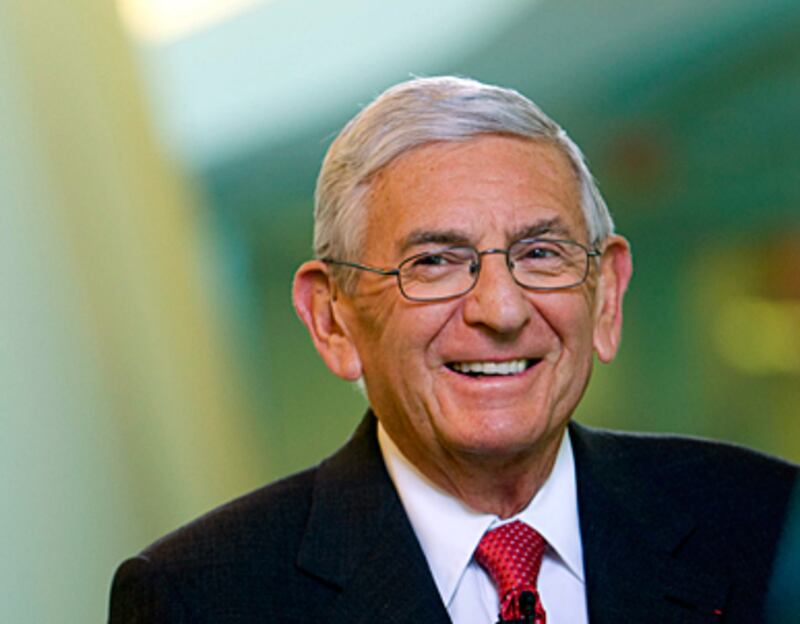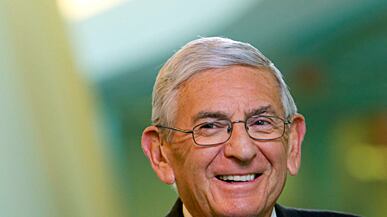In Southern California, this was the most anticipated civic decision in years: Where would Eli Broad build the museum to house his multimillion-dollar art collection?
Finally, the richest man in Los Angeles revealed his hand: He would build the museum downtown.
Broad’s recent decision, and how he arrived at it after a drawn-out competition between Beverly Hills, Santa Monica, and Los Angeles, illustrates how the billionaire homebuilder does business, and how he has come to be the premiere cultural force in L.A.
Broad (pronounced as in goad) has in the last few years donated more than $100 million to the arts, culture, and education in the city, and now has a say in what goes on at most, if not all, of the major cultural institutions—from the city’s major museums to Walt Disney Concert Hall, home of the L.A. Philharmonic.
Broad is also heavily involved in education and science, giving $500 million to create and fund the Broad Institute of MIT and Harvard for the study of genomes, and many millions to both UCLA and USC for stem-cell research. He has created a learning academy for professional educators, and a $2 million national education prize, awarded annually to high-performing school districts.
He has also invested in educational reform, donating $100 million to charter-school organizations as well as $500,000 to Davis Guggenheim's recently released education documentary, Waiting for Superman. And just this week, he spent $500,000 to come to the rescue of a cash-strapped charter-school company operating 15 schools in low-income neighbors in L.A.
“I think he’s crazy as a loon half the time, and I don’t agree with him. But I have great admiration for him, and I actually like him.”
In terms of research questions or what is taught in the classroom, Broad has mostly played a hands-off role.
Not so in the arts.
“Eli has done phenomenal things,” says Charles Young, the former chancellor of UCLA whom Broad tapped as interim director of MOCA before the current director, Jeffrey Deitch, was hired. “He’s extremely generous. But generous in ways that are not, ‘Here’s the money, go do it.’ But in ways that are, ‘Here’s the money, let’s you and I get it done.’ It’s fair to say that when Eli does something, Eli wants to be into it up to his eyeballs. That’s the only way he can operate.”
“In the arts,” adds Young, “Eli probably feels he knows as much about what’s going on as any of the other people he’s dealing with, including the professionals.”
The portrait that emerges in dozens of interviews is of a driven, exacting, and detail-oriented man involved in all facets of L.A.’s cultural life, someone with an amazing ability to simultaneously focus on the big picture while, as one interviewee put it, “telling you which postage stamp to use.”

A tireless advocate for the city, Broad spearheaded efforts to finish the construction of the celebrated Frank Gehry-designed concert hall, Disney Hall, when fundraising stalled, and he has continued to encourage public and private development of the surrounding downtown area.
His $50 million paid for (most of) the new Broad Contemporary Art Museum at the Los Angeles County Museum. An additional $30 million stabilized the faltering contemporary art museum, MOCA. Broad has said he is willing to spend another $100 million to build his downtown museum, tentatively named the Broad Collection. (The public may have to kick in millions of dollars more.)
The downside of what critics see as the intrusive nature of his philanthropy: Projects paid for by Broad tend to come with their own built-in costs: conflicts and battles for control.
The obvious historical parallel is that he comes out of a line of L.A. tycoons—Norton Simon, J. Paul Getty, Armand Hammer—men who built wealth and then art collections and city monuments to themselves.
However, the most fitting comparison may be the movie mogul Louis B. Mayer, a self-made man who controlled his empire (and the talent who worked for him) with a steely grip. Except in Broad’s case, that steely reach extends to most of the city’s civic and cultural institutions. “When a supporter has so much power,” says one knowledgeable source, “that meddling starts to feel like a real intrusion. It’s a massive force to tell you how to sharpen your pencil.”
Broad, reached through his press office, says in an emailed response it’s not his fault if he takes up a lot of space in L.A.’s art world. “There are not enough people stepping up to the philanthropic plate in Los Angeles.” His goal, he says, is to heighten the city’s cultural profile. “Los Angeles is one of the four cultural capitals of the world, but we don’t attract as many cultural tourists as New York, London or Paris. I want to change that.”
Broad’s beginnings were humble, his aspirations anything but. His parents were immigrants from Lithuania, his mother a dressmaker; his father ran five-and-dime stores. At 22, and by then an accountant, Broad realized that his home-building clients were making much more money than he was, and so he teamed up with his wife Edythe’s cousin to form Kaufman & Broad. Their revolutionary insight? The advent of electrical heating meant that basements were no longer necessary, and that by building homes without basements they could offer much lower costs.
Almost 20 years later, with Broad having become the first homebuilder whose company was traded on the New York Stock Exchange, Kaufman & Broad bought an ailing insurance company for $65 million. Broad took charge, turned it around and later merged it with the giant AIG to the tune of an $18 billion payday.
Today, the retired billionaire, who Forbes estimates has a personal wealth of $5.8 billion, is a full-time philanthropist. But this isn’t philanthropy as usual, the old ‘donate and sit back and watch the money work its magic’ sort of thing. Rather, this is something he describes as “venture philanthropy”—the application of his business and investment strategies to giving. Think basements, or the lack thereof, and returns on investment. But what kinds of basements and what kinds of returns?
Listen to Renzo Piano, the world-renowned Italian architect who was handpicked by Broad to build the Broad extension to the county museum. “I lost on the basement, and I won on the roof,” Piano has said, and critics say there is more Broad than Piano in the finished building, which resembles a Coors bottling plant clad in the Sacre-Coeur’s travertine.
“I don’t think there’s a need to go back and say, ‘What would another architect have done?’” says the director of LACMA, Michael Govan. “Renzo Piano is a great architect. But you know, it’s not the choice of architect; it’s how you work with an architect.”
(Piano did not respond to a request for comment.)
In remaking the city, Broad has hired some of the most famous architects working today. But he also has the perhaps singular distinction of owning a home that has actually been disowned by one of those great architects. Gehry, who provided Broad with sketches for his house, had a falling out with the billionaire, and was replaced by other architects who finished the house, based on his sketches. “It looks kind of like a Frank house, but not a Frank house,” says the celebrated architect Thom Mayne. “It’s kind of weird.”
Mayne, who is also friendly with Gehry, Piano, and Dutch architect Rem Koolhaas (who also, according to Mayne, also had a falling out with Broad but who declined to comment for this story), says he knew what he was getting into when Broad approached him to design the new Broad museum.
“I knew the history, I didn’t come in naïve. But I’m thinking, ‘Well, I’m a tough guy, I can deal with tough clients, and I’ll be the first one that kind of hammers this through. Ahhhh… it didn’t work out that way,” he says. “We worked for a while, and we just reached a mutual understanding that we weren’t going to work together… It’s my city, and I didn’t want to produce a building I wasn’t proud of.”
Mayne is quick to note that he admires Broad, but says they just didn’t have the right chemistry. “Eli’s a business guy,” says Mayne, as he begins to snap his fingers, loudly. “He moves like this, he wants answer [snap!], answer [snap!], answer [snap!], no we can’t do this [snap!], no we can’t have that [snap!]. And it works in his world. And it made him very successful. Without question, he’s a decision-maker, and he’s made huge amounts of money. And I respect that. Well,” he adds, correcting himself, “I accept that.”
Still, according to Mayne, the two left on friendly terms, with a hug. “I think he’s crazy as a loon half the time, and I don’t agree with him. But I have great admiration for him, and I actually like him. You can say anything to him. He’s armor-less. I remember saying, ‘Eli, that’s the stupidest thing I’ve ever heard.’ And he’d just go—‘Eh, next sentence’”
Broad himself offers this: “I’m strong-willed. Architects are strong-willed. You get the best results with a strong client and a strong architect working together.” And in terms of the disowned Gehry house, Broad simply says: “I was too impatient and he was too slow.” (Gehry declined to comment for this story.)
To critics who charge he wields too much power, he responds: “Why don’t they join in the L.A. cultural life, rather than [sit] back and [offer] commentary?”
At least one other person has stepped up, and that is Lynda Resnick, who along with her husband Stewart paid $45 million of the $54 million for the new Resnick Pavilion at LACMA, also designed by Piano, which opens this week.
Listening to LACMA Director Michael Govan talk about Resnick, you almost get the feeling he has another big donor in mind when he says: "Lynda's done all the right things. She let the museum pick the architect; she let the museum do the work. She didn’t say, ‘No, I want to build it over there, I want a new architect.’ She just said, ‘If that’s what you think makes sense, let’s go with it, because that’s what’s right for the city.'”
Tom Christie is the Senior Features Editor at the LA Weekly, where he has worked since 1995. He is a graduate of UCLA where he studied Film and Creative Writing.






